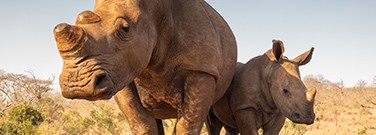Bone-Crushing Dogs Preyed on Rhinos and Camels in an Ancient Nebraskan Savanna

By Gina Wynn
Nebraska was a very different place 12 million years ago. Now a shrinking expanse of grassland, in recent history, the area’s animal population has included typical North American species of bison, elk, deer, pronghorn, prairie dogs, grizzlies, wolves, and more.
Different animals, a different landscape, and a different climate would have made Nebraska unrecognizable in the Middle Miocene Epoch, according to Alison Pearce Stevens, author of Rhinos in Nebraska, The Amazing Discovery of the Ashfall Fossil Beds, and the Science News for Students article “Rhinos, camels and bone-crushing dogs once roamed Nebraska.”
Uncovering an Epoch
Paleontologists excavating at the Ashfall Fossil Beds State Historical Park and National Natural Landmark in north-central Nebraska have discovered that 12 million years ago, rhinos, camels, pony-size horses, saber-tooth deer, and large bone-crushing dogs inhabited the area now called Nebraska that was more akin to an African savanna. Dotted with shrubs and trees, it strongly resembled Serengeti National Park in East Africa.
The climate stayed above freezing all year long and seasons were determined by rainfall. In the wet season, animals would travel long distances to visit popular water holes that would eventually evaporate in the dry season.
Erupting into Chaos
The Ashfall site has been providing a rare opportunity for researchers to get a glimpse into a past epoch since 1971, when University of Nebraska-Lincoln Geologist Mike Voorhies — who had been surveying the area for years — spotted a jawbone sticking out of the side of a gully. When fully unearthed, experts determined that it was part of an entire baby-rhino skull, the second that had been retrieved from the site. Both fossils had been covered and preserved by a thick layer of ash.
Years of excavation in the area have since revealed hundreds of complete skeletons layered on the sandy bottom of an ancient water hole. The research team found that the ash that had protected the animal remains for so long was from a supervolcanic eruption of a volcano some 1,000 miles (1,600 kilometers) west of Ashfall in southwest Idaho. Its massive eruption 12 million years ago spewed a layer of the thick flaky substance that stretched as far as the Atlantic Ocean.
Suffocating Savanna
The foot of ash that blanketed the water source was made of tiny glass shards that meant doom for the animals. The thirsty animals who went there hoping to find a drink most likely inhaled the ash and suffered fatal lung damage. Thus, huge numbers of animals ended up suffocating and dying.
The layers of the skeletons discovered in the watering hole show that animals died in waves according to their size: birds and turtles died first, next were dog-sized saber tooth deer, then horses, camels, and rhinos. The mass animal grave was found beneath 8 feet (2.5 meters) of ash that most likely blew into the water after the animals died.
Hunting the Hunters
What was missing from the fossil pile was predators. The paleontologists only found evidence of two small predatory dogs in the remains, which would not explain why some rhino skeletons were found with legs ripped askew and ribs strewn about that had been scraped clean by teeth. This was a sign that large predators had been scavenging the dead.
The researchers made a breakthrough when a team member took note of the thin white bands in the ash columns. Originally thought to just be different colored ash, they turned out to be fossilized algal mats. The mats provided the key to solving the mystery of the large predators.
Prehistoric Clues
In flattened sections of the algal mats — presumably made by the weight of an animal — they found large paw prints, most likely made by gigantic bone-crushing dogs. The footprints also provided clues about when the scavenging occurred. Prints in the lower parts of the algal mats showed that the predators were feeding on animals as they were still dying in the water. A set of prints 6 inches (15 centimeters) higher suggested that the hyena-like dogs came back to the site days or weeks later.
What happened to the bone-crushing dogs after that? Researchers still don’t know if they found a way to survive the choking ash or if their skeletons are buried somewhere in an unexcavated area of the fossil bed. Why hasn’t the team found remains of elephants or saber cats that would have also been living in the area at the same time? These are some of the many questions paleontologists hope to answer as excavation of the site continues.
Discussion Questions
- Why do you think Nebraska is different now than it was 12 million years ago?
- How did rhinos, camels, and elephants get to Nebraska?
Vocabulary
- Paleontologist
- Pronghorn
- Fossils
- Predator
- Algal